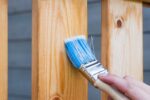How to Build a Shed from Scratch | 2023 Guide

If you’re looking to make full use of your garden, a shed or garden building is essential. However, purchasing pre-made sheds from suppliers can be expensive. Building your own shed from scratch is a cost-effective alternative. Although somewhat challenging, constructing a custom-made shed is very achievable. Interested in undertaking this rewarding DIY challenge? Our guide explains everything you need to know when building a shed from scratch.
Before You Build
Before you turn your attentions to any advanced planning work or consider ordering materials, you should first consider the scope of your project. If you’re thinking about building a particularly large shed structure, you may need to seek out planning permission prior to carrying out any work. However, if you only intend to construct a small shed for storage or a modest outdoor workshop, planning and building permission will not be required.
Preparation & Foundations
Ideally, your shed should have an even foundation on which you can assemble your structure. You may be lucky enough to working with a paved outdoor space or an area with heavy-duty decking. If so, you should be able to build directly on top of these foundations. However, if you’re working with an unkempt garden, levelling the existing ground may be required. Although you can use treated timber and decking panels as a foundation for a shed, it’s best to utilise concrete paving slabs as a base. Concrete is particularly hard-wearing and will prevent moisture from rising up and penetrating the foundations of your newly erected shed.
Regardless of what type of foundation will lie beneath your shed, you should definitely consider using deck piers. These piers will provide a convenient anchoring point for support beams that can be place beneath the floor of your structure. These piers should be placed fairly evenly, although the exact placement of them will depend on the exact layout of your shed.
Next, you should attach support beams to these piers. Attach them lengthwise, as this will provide the best support for flooring joists. Use high-quality metal fasteners for attaching your support beams. Make sure any fastenings have pre-drilled nail holes so you don’t have to worry about making your own.
Next Steps
Once your support beams have been positioned and attached, you can think about attaching joists. Rim joists should be attached first. These will need to be positioned along the outermost supports you have laid down already. These joists will of course need to match the measurements of the beams you are placing them on top of of. Flooring joists should be your next focus. Flooring joists will be placed in the opposite direction to your support beams.
Although they’ll be shorter than your support beams, you’ll need far more of them. Start with two flooring joists at either end, before attaching additional joists. Make sure spacing between these flooring joists is no greater than around 13 inches. This will provide you with maximum stability. It’s also a good idea to use attach blocking cuts between your flooring joists, as this will prevent beams from moving around as you install fixtures and fasteners.
Once all flooring joists have been laid out and secured into place, you can attach a hard-wearing plywood sheet on top of the floor foundation you have created. If your shed is only small, you may be fine using a single piece of plywood. Larger shed bases may require you to use multiple pieces of plywood. Just make sure any plywood pieces have cut precisely. Nail these sheets in place firmly with premium nails
Constructing Shed Walls
Much of the hard work is now complete and you can now focus on constructing the walls of your shed. To build framework for a wall, you’ll need ensure top and bottom wall beams measure the same length as your flooring beams. The vertical wall beams can be as tall or short as you want. You will also need additional vertical beams to ensure your wall framework is particularly sturdy.
Build a complete framework for one of the longest side first, before moving onto the second one. If you want your shed to have a sloping roof, the second side panel should be made from shorter vertical beams. However, if you want to keep things simple with a flat roof, simply duplicate what you have just done, but ensure you incorporate a sturdy door frame.
Next, you can construct the framework for the two smaller sides of your shed. Once you have four complete wall frames, you can secure them to your shed base. Make sure you use high-grade nails and screws, incorporating steep plates and connector fixtures where required. Finally, you can add roof rafters. Attach these roof beams with the narrower side making contact with you shed framework and then secure them in place.
As you did when putting together the shed flooring, use blocking pieces to secure your roof rafters firmly in place. Once the blocking has been installed, secure plywood sheeting to the top of your roof rafters. Again, make sure this material has been precisely measured prior to cutting.
Cladding & Felting
Your shed should now be taking shape. You can now focus on cladding it. You’ll find plenty of affordable siding material available, although high-grade plywood can also be used. You can use pretty much any material for this step, provided it is hard-wearing and weather-resistant.
Once the shed framework has been kitted out with cladding or siding, turn your attention to the roof. Using tar paper is always a good idea as this will provide effective protection against the elements. When adding tar paper, it is always a good idea to overlap individual sheets to ensure that rain cannot permeate beneath and warp underlying plywood material. Tar paper should also be slightly rolled over the edges of your roof rafters to ensure no wood is left exposed to rainfall. If you have more of a budget to work, you may prefer to use shingles to finish your roof.
You can now also hang a door in the door frame you prepared earlier. If your door frame has been produced to standard size, you can pick up a ready-made door from a hardware store or online retailer. However, making your own door is fairly straightforward. Before you add any locks or additional hardware to your shed, you will want to carry out any wood treatment or painting jobs. Once sufficient coats have been added, you can finally add the finishing touches to your shed and start using it.






